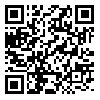BibTeX | RIS | EndNote | Medlars | ProCite | Reference Manager | RefWorks
Send citation to:
URL: http://bcn.iums.ac.ir/article-1-211-en.html
Localization of sources in patients with focal seizure has recently attracted many attentions. In the severe cases of focal seizure, there is a possibility of doing neurosurgery operation to remove the defected tissue. The prosperity of this heavy operation completely depends on the accuracy of source localization. To increase this accuracy, this paper presents a new weighted beamforming method to precisely localize the focal seizure sources from the electroencephalogram (EEG) signals. First, synchronization value is determined just between each two adjacent channels, and the channel with maximum average in synchronization index is selected as the nearest channel to the dominant focal sources. Next, weight of each channel is determined based on its Euclidean's distance to the selected channel. The determined weights act as a prior knowledge, incorporating in multiple signal classification (MUSIC) and some other beamforming methods to localize the exact place of seizure source. Next, the effect of estimated source is removed from the signals repeatedly to find the second focal source. This process continues till all focal sources being determined. To verify and validate the proposed scheme, 65 channels EEG signals were simulated and a linear weighting was applied to the three groups based on some sources. The proposed scheme and some known beamforming methods such as conventional beamformer, MUSIC, Weighted MUSIC, Capon’s, Eigenvector and also SLORETA were applied to the simulated epileptic signals to find the location of sources. Experimental results reveal the superiority of the proposed method to the rival schemes in terms of localization accuracy, both in clean and noisy environments
Received: 2012/04/19 | Published: 2012/02/15
| Rights and permissions | |
 |
This work is licensed under a Creative Commons Attribution-NonCommercial 4.0 International License. |





